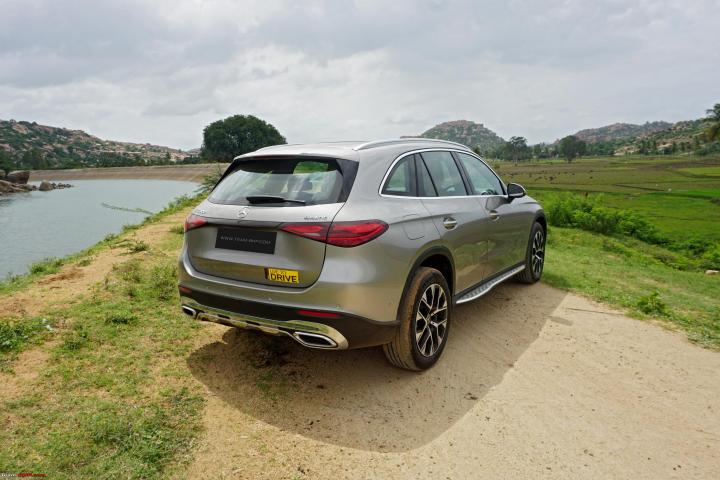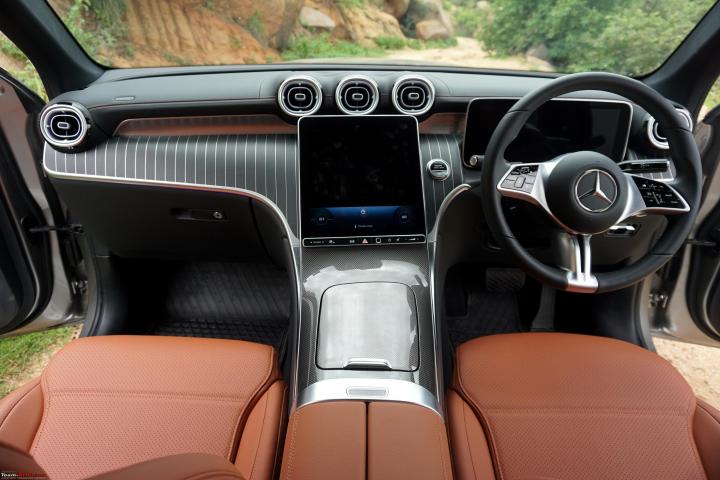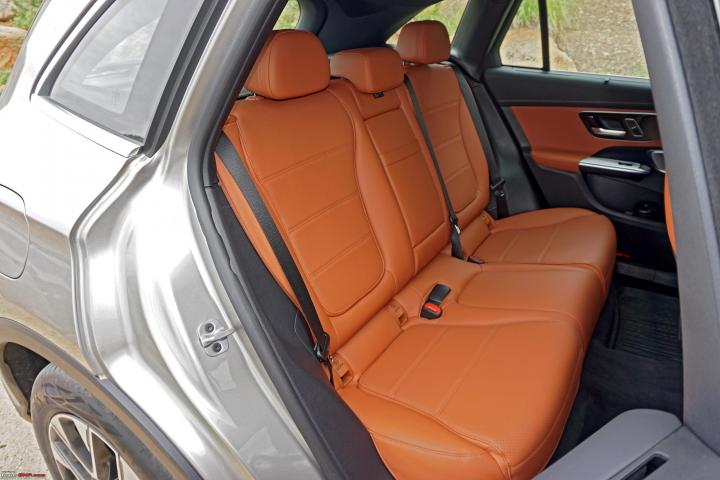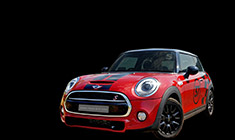News
2023 Volvo C40 Recharge Review : 8 Pros & 8 Cons
The Volvo C40 Recharge can easily cruise at triple-digit speeds on the highway and when you need to overtake a slower vehicle quickly, just floor the A-pedal and fly past the vehicle.
Volvo C40 Recharge Pros
- Sharply styled Crossover. Volvo’s designs sure are head-turners!
- Solid build & top-notch quality, inside out
- Powerful drivetrain with 402 BHP, 660 Nm and AWD gives it sportscar-like performance
- Zero emissions, cheap running costs & green image will appeal to a lot of people
- Real world range should be ~400 km, which is enough for most users
- Excellent high-speed stability coupled with sorted handling. Mature ride quality at speed too
- Loaded with features such as panoramic pixel technology headlamps, electric front seats with extendable seat bases, one-pedal driving, button-less starting procedure, air purifier, 13-speaker Harman Kardon sound system, etc.
- 5-star NCAP rating, top-notch safety kit & level 3 ADAS to keep you safe
Volvo C40 Recharge Cons
- Will be more expensive than the XC40 Recharge which is priced at 60 lakhs on-road
- Rear seat comfort levels are mediocre. Raised floor & upright seatback. It’s best for just 2 & ingress / egress are tricky too, due to the sloping roofline
- Coupe-like rear styling can be polarising. Will divide opinions
- Poor rearward visibility due to the acutely-angled rear windscreen & C-pillar design
- Spare tyre is placed above the boot floor and eats into luggage space
- Missing features such as ventilated seats, head-up display, adjustable regenerative braking, wireless Apple CarPlay & Android Auto, rear wiper, full-size spare tyre (has a space saver tyre) etc.
- Firm low speed ride. Liveable, but not plush in the city. You feel bad roads in the city
- Small dealership and service network isn't a patch on its German competitors
Read Team-BHP's detailed 2023 Volvo C40 Recharge Review.
- Tags:
- Indian
- C40 Recharge
- Review
News
Why I recommend the Comet EV over the Tiago EV for city commutes
I spent 10 days with it for shoots, and it impressed me all the time.
BHPian parrys recently shared this with other enthusiasts.
To everyone who has purchased a Comet EV, congratulations on your bold & smart choice.
Haters going to hate, but the Comet is a very decent car for city commutes.
I spent 10 days with it for shoots, and it impressed me all the time.
For 3 days, during my shoot, I drove it from Thane - Eastern Freeway - CST - Asiatic Library - Gateway of India - Bademiya - Marine Drive - Worli Sea Face - Bandra Worli Sea Link - Mount Mary Church - Thane. On all 3 days, after starting my journey at 100%, I would return home with 40% or a little more battery left.
It is such a head-turner, that you have 0 privacy inside the Comet. Everyone wants to peep inside.
Compared to the Tata Tiago EV, I would recommend the Comet EV. Tata's quality control, niggles and overall average packaging does not make a cut for me, in any of the segment where they are present.
Some Mumbai nightlife shots...
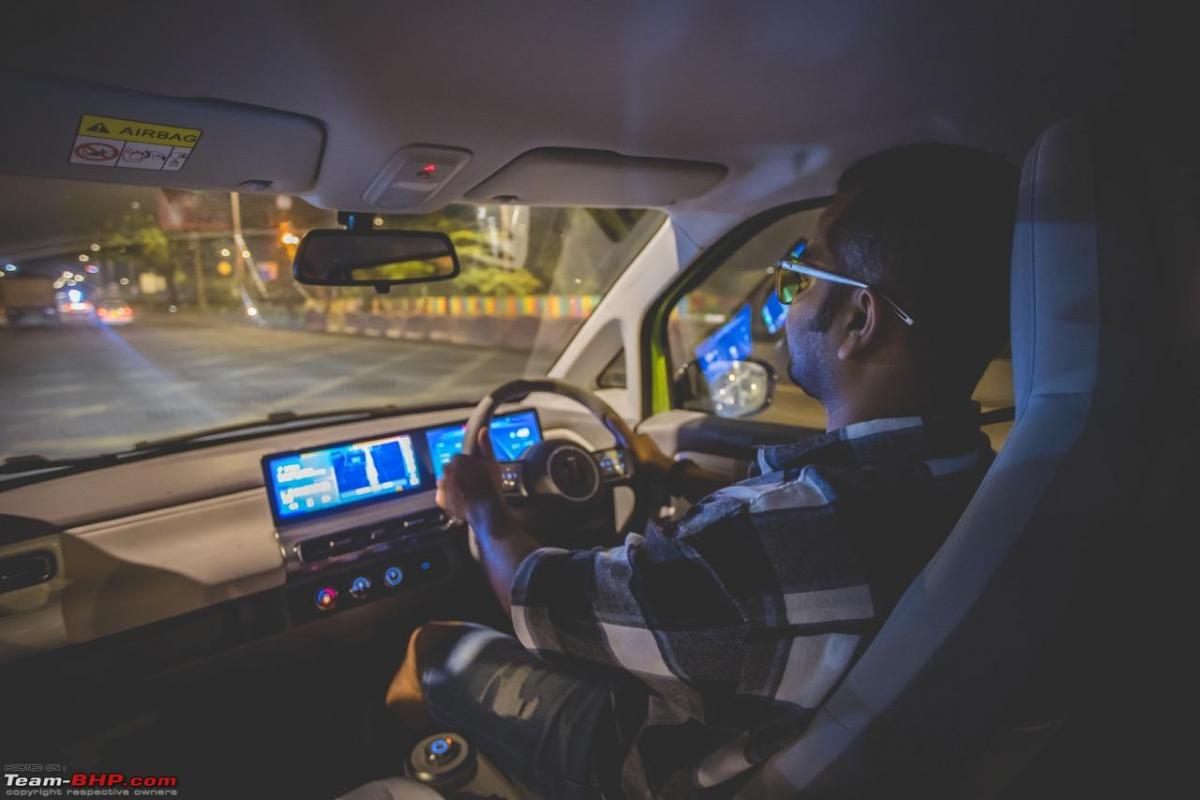
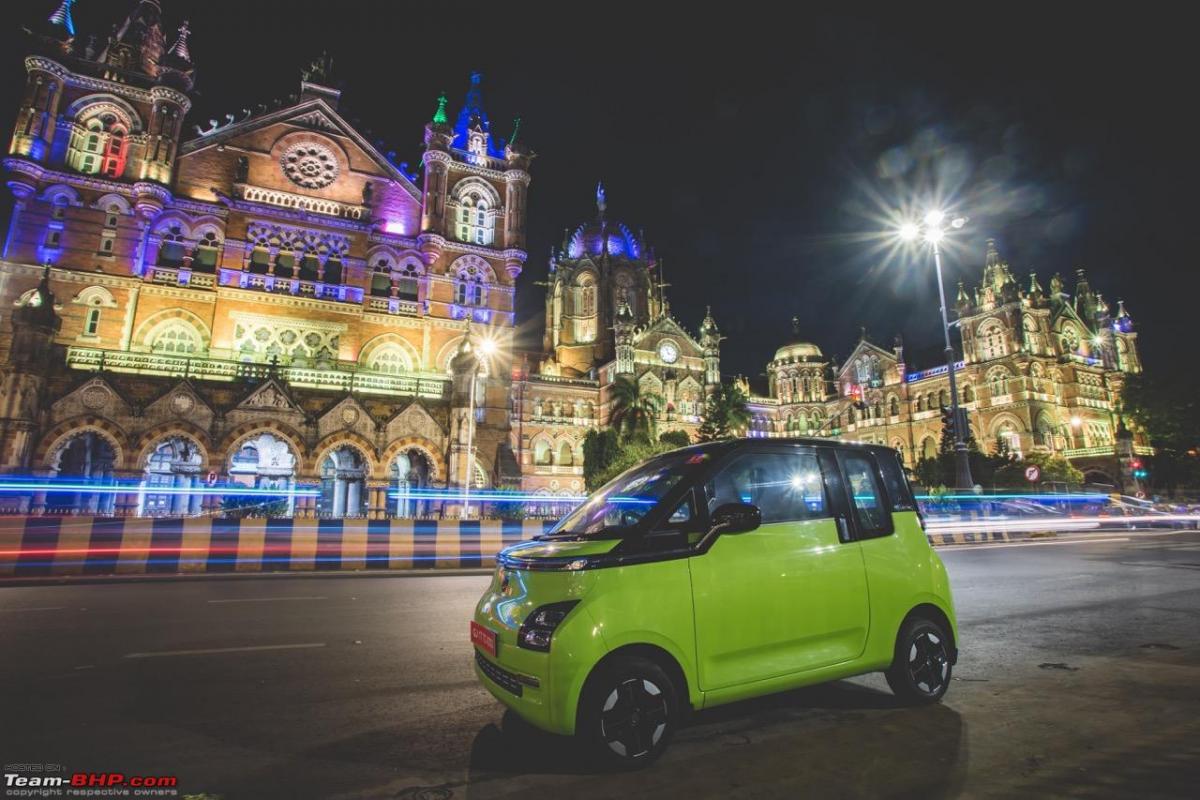
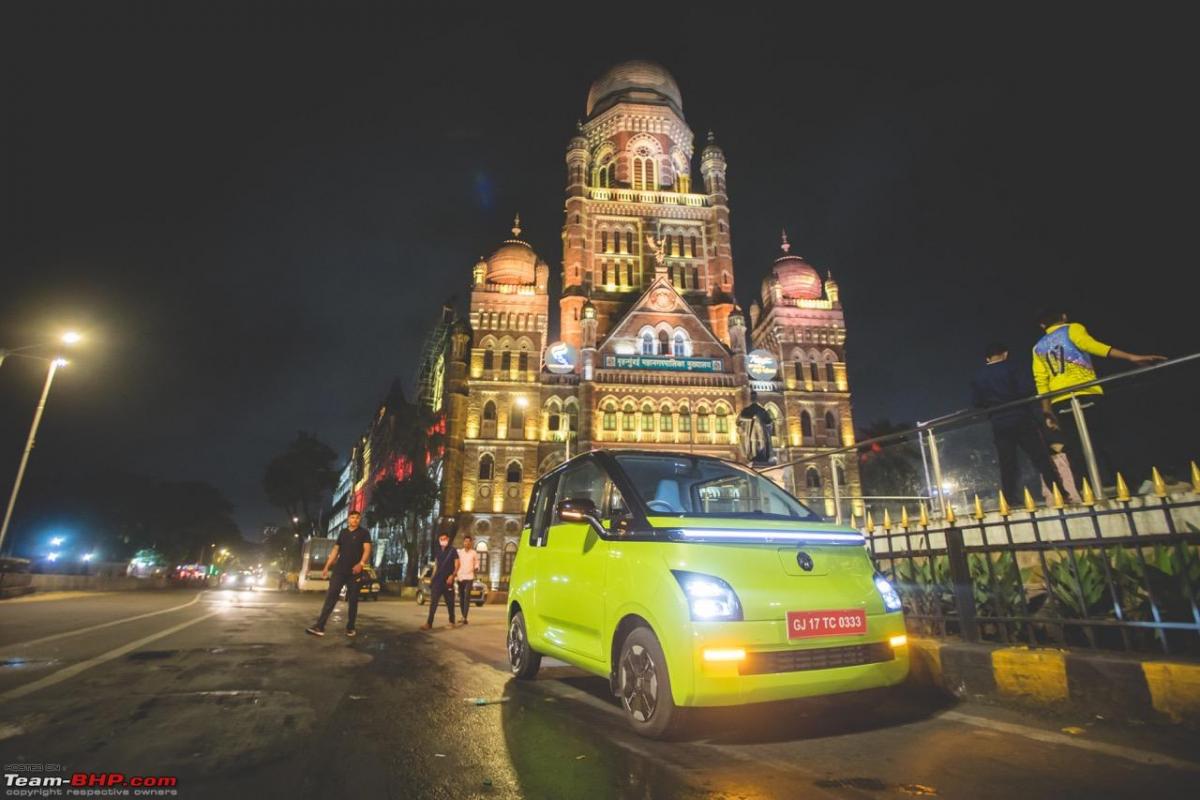
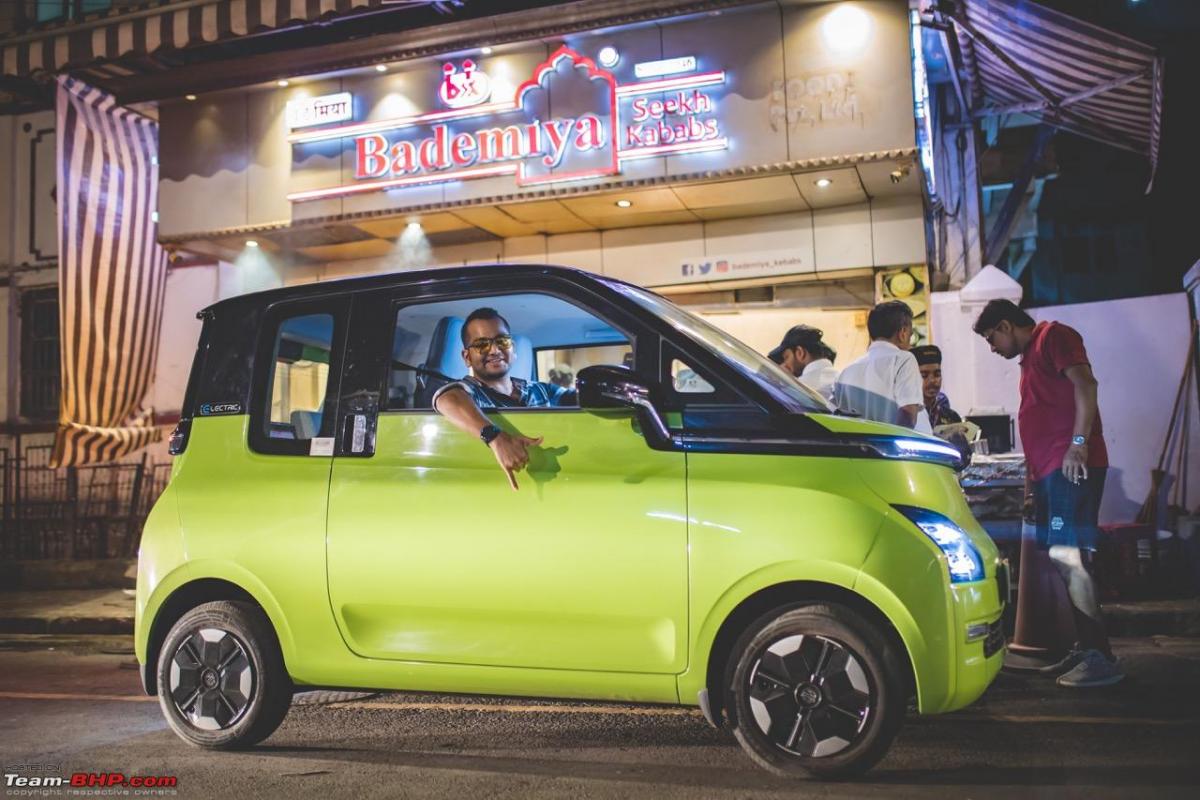

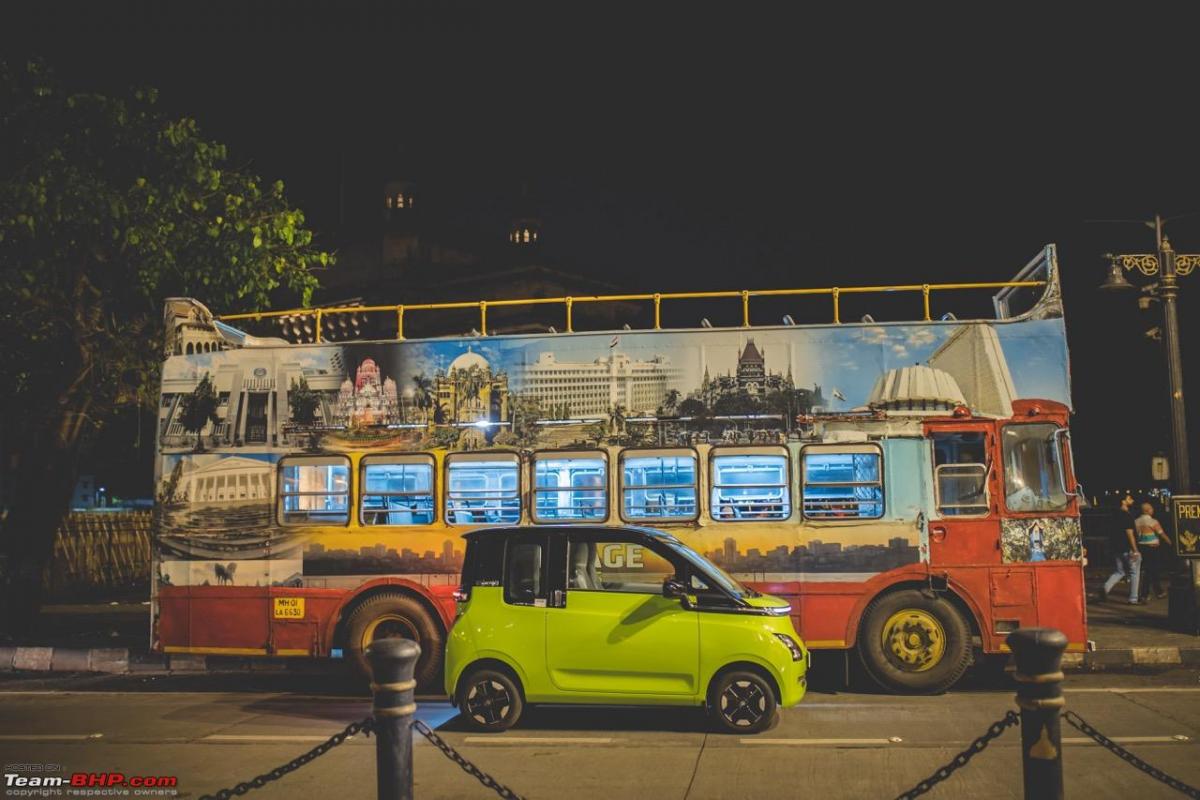
Here's what BHPian Maky had to say on the matter:
I too live in Bombay, could you give some specific numbers on the range, please? 100% to 40% or to even lower the charge if you've pushed it. Were the conditions bumper-to-bumper traffic or was it free-flowing traffic? does it even matter in an EV?
I am considering this purchase for my mom who is very short and would appreciate a taller seating position, has very little running and drives short distances but still would love to get some real-world figures on the range.
Here's what BHPian parrys replied:
Have not purchased it, it was with me for a review shoot.
I drove it just the way I drive my Jazz diesel.
Speed ranged between 60-70 kmph on the highway.
Day 1 out of the 3, we were 3 adults on board.
110-115 km drive, ~60% battery charge utilised.
Free-flowing traffic mostly, we were shooting at night.
I had it for nearly 10 days with me.
Did not get my Jazz out except for shoot tracking in these days.
It was as effortless as it could get.
AC's performance, in my opinion, could have been stronger.
Have to be a little careful when driving over big potholes or broken roads, as the wheels are small.
For reference, I stay in Hiranandani Estate Thane. For an elderly person, who would mostly commute within a 10-15 km radius, this is a good buy.
Check out BHPian comments for more insights and information.
- Tags:
- Indian
- Comet EV
- Test Drive
- Review
News
Pros & cons of our MG Comet: How it complements my Hyundai Alcazar
Both my wife & I are EV aficionados, having owned an E2O before and an iQube now.
BHPian herculesksp recently shared this with other enthusiasts.
We added an MG Comet (Plush) to our garage a few days back. We had booked this as soon as bookings opened in May. Subsequently, we decided to buy it via my Wife's company lease plan and the process took a little bit of time. After about a month since they started commencing deliveries, we received our MG Comet last Thursday.
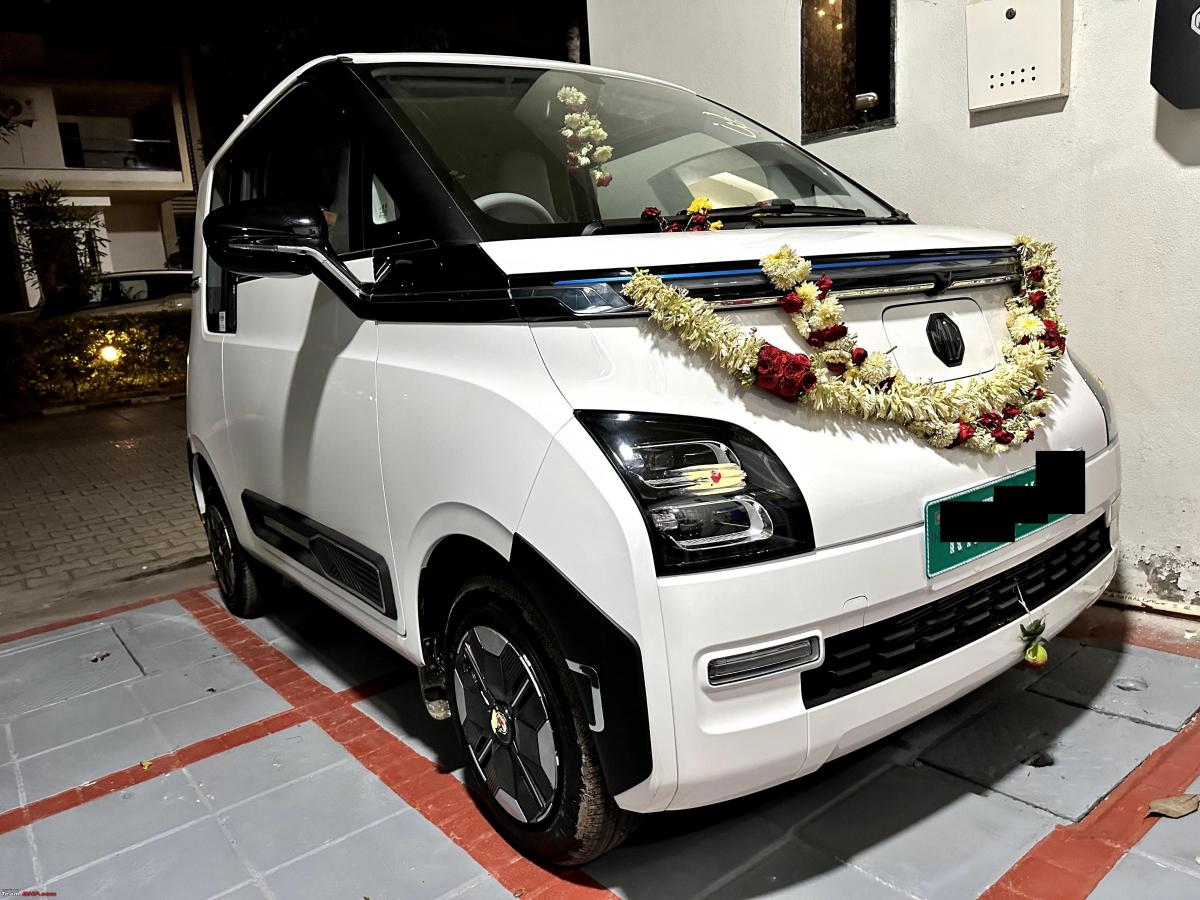
This complements the Hyundai Alcazar in my garage and fits very well.
There were two primary reasons for getting this car:
- The wife wanted a compact car for her driving. She lost confidence once European design cars started coming about (and she couldn't see the bonnet corners anymore) and I also wanted a compact car for city runabouts. Most of the EVs coming out today are huge (except for Tiago EVs) and a pain to drive on narrow roads and park in any nook or corner.
- We really really wanted an electric car as the second car. We previously had an E2O which we loved. We also own a TVS iQube and used to have a TVS Scooty Teenz Electric almost 15 years back. So we are hard-core EV aficionados.
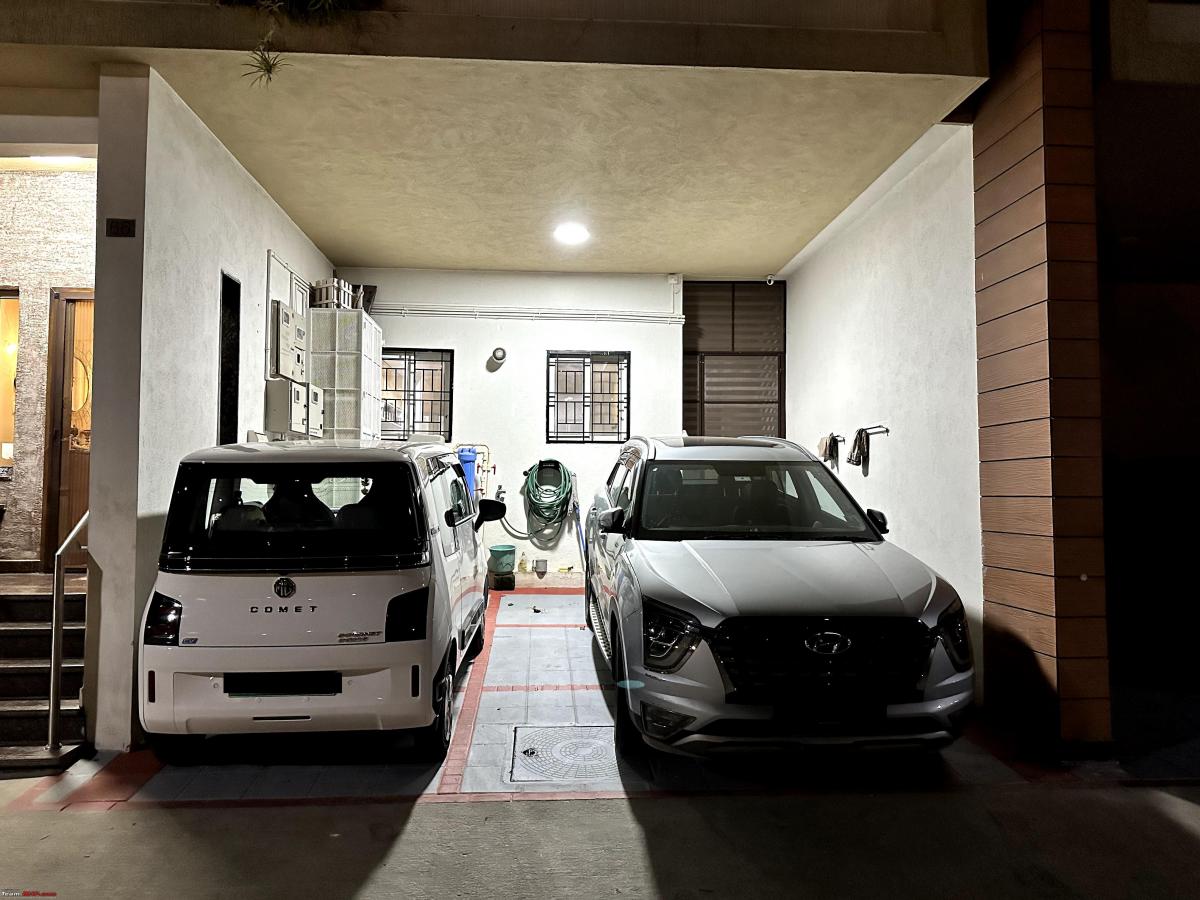
Mini-review:
Having driven it for about 60-70 km in the last 3-4 days, I am fairly satisfied with the purchase and the intention of buying it. Following are my observations.
Pros:
- Super compact and easy to drive on crowded roads and also to park. The width is about the length of a 2-wheeler.
- Smooth and refined and good power - good overtaking prowess
- Interiors feel luxurious and premium
- Tall seating and visibility are very good for someone about 5'5" or under
- Wireless Android Auto and Apple Carplay that runs on Bluetooth. Even my Alcazar doesn't have it.
- Open area under the dash is awesome and makes it fun to jump between the driver and the passenger seat. I can park in tight spots and slide out through the other side.
- Cubby holes just below the A/C vents are nice to keep drinks cool. I haven't tried to see if it actually fits a coffee cup or Coke can. The key fob in there gets very cold though.
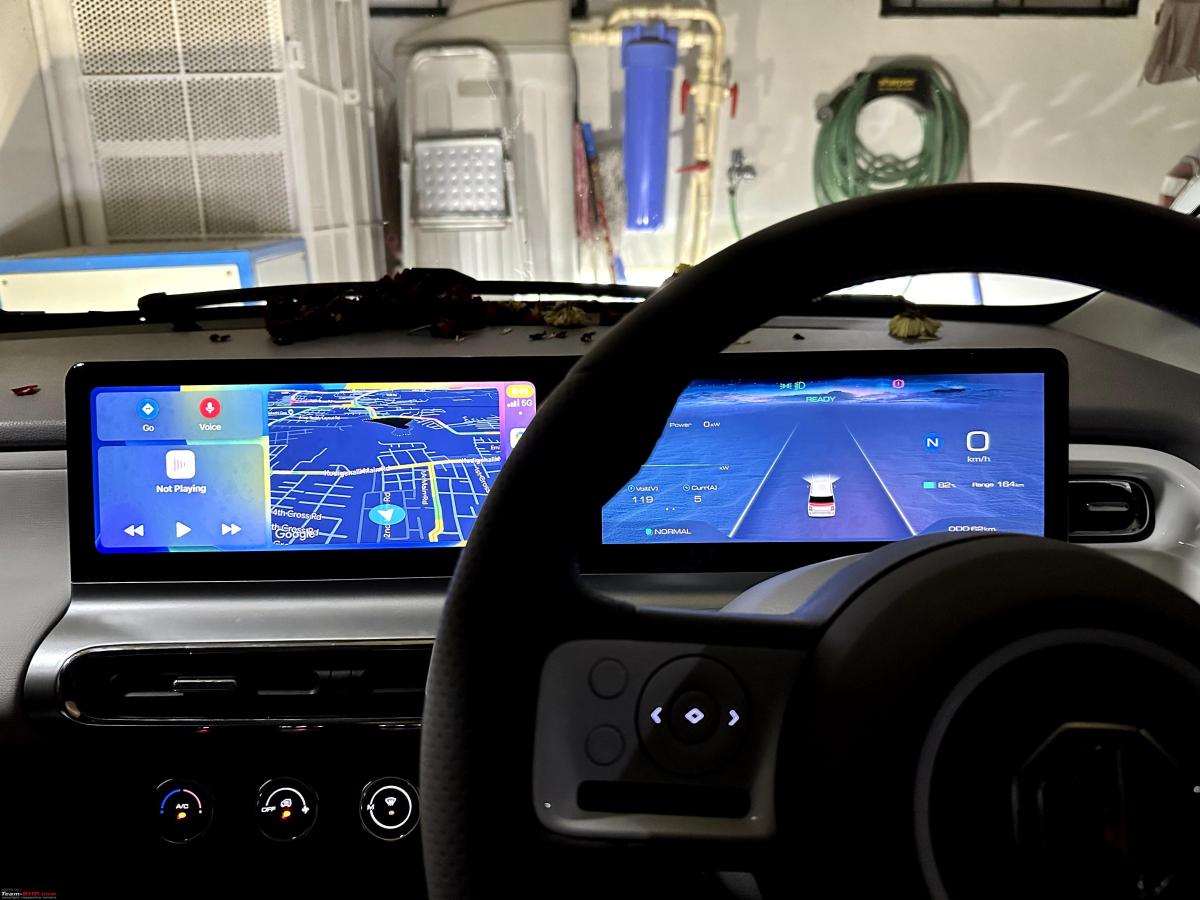
Cons:
- The ride is a tad uncomfortable. It is very bouncy at speeds > 40kmph and body roll is very high when you take corners at speed.
- Seats aren't the best. There is no under-thigh support and after about 30 mins of driving, my hamstrings hurt. The pedals are too forward and could have been more inside the footwell.
- Visibility for taller drivers (I'm 6') is very bad. The IRVM blocks my view to the left and creates huge blind spots when turning left or at intersections
- The instrument/entertainment cluster is poorly placed. The part where they overlap is covered by the steering wheel. So for those that use Apple Carplay, you cannot see the rightmost column with the app switcher/time etc.
- There is no glove box or trays behind the gear dial. This makes it tricky to place items like mobile phones (esp when charging), documents etc.
- A/C temperature setting is hit or miss. I might be spoilt by auto climate control, but I have to keep jumping between the L2 A/C setting which gets super cold, and L3 which starts heating up the cabin. There is no smooth grading of the temperature setting.
- The car doesn't seem to get DRLs. The front bar of light turns on when I switch on the pilot lights which include the rear bar and the license plate lights. This is a miss. The front bar will make an awesome DRL.
- It has rear fog lamps which I don't find useful for a car this size. It has a weird rocker switch - I need to check if this works or is defective.
- Rear left visibility is pretty bad due to the thick C pillars. I also need to get used to estimating the left side of the car. It feels weird without a bonnet to judge the front left of the car. Maybe this is how the Maruti Omni feels too?

Other things - I am definitely spoilt by the Alcazar and it's creature comforts.
The 360 camera makes it way more easier to drive than the Comet even though it is twice the size. I also miss the automatic everything on the Alcazar - auto A/C, auto headlights etc. The sound system is adequate for the podcasts that I listen to on my commute.
I had also ordered a dual-tone white with a black top, but the car came without a black top. They said that the black roof painting is done by the dealers using factory equipment, but the factory delivers only full candy white cars. I find this hard to believe. They said the painting equipment was defective and hence they couldn't paint it before delivery. I now need to give the car for 3-4 days so that they can paint it. I am worried about this but I need to go through it since the car is registered as a dual-tone car in the R/C.
Interestingly, the car didn't come with any accessories like idols, perfume etc. While I'm happy they didn't force that on me, I now need to go look for an idol for the car. I didn't have that problem for the last 15+ years.
Check out BHPian comments for more insights and information.
News
2023 Mercedes GLC SUV Review : 10 Pros & 8 Cons
The 2023 Mercedes-Benz GLC SUV has scored a 5-star safety rating in Euro NCAP crash tests. Some standout safety features include 3-point seatbelts for all five occupants, 7 airbags, Blind Spot Assist, Active Lane Keeping Assist, Car to X communication, Active Brake Assist, Active Parking Assist, 360-degree camera, Pre-Safe and Attention Assist.
Mercedes GLC SUV Pros
- Great looks matched to solid build quality
- Premium quality interiors, supportive seats, filled with technology
- Adequate interior space and 620 litres of luggage-carrying capacity
- Fast and competent petrol and diesel powerplants
- The Mercedes 9-speed AT gearbox is now very good! And smooth too
- Well-damped suspension offers mature ride quality
- Fun to drive (unlike the last-gen GLC)! Very good handling, well-calibrated steering & excellent high-speed manners
- Loaded with features such as seat kinetics, latest-gen MBUX, transparent bonnet & lots more
- Impressive 15-speaker Burmester audio system
- 5-star NCAP rating, top-notch safety kit & a suite of electronic aids to keep you safe
Mercedes GLC SUV Cons
- Expected to be even more expensive than the outgoing model! Old GLC 220d was priced between 82 – 85 lakhs on-road
- More powerful 300d tune is sadly not offered on the new GLC. Period. We hope it is introduced at a later stage
- Touch-type controls can take time to get used to. Physical buttons are gone! Even ORVM adjustment is touch-based & non-user-friendly
- Back seat is more suitable for 2 healthy adults and a child. Not 3 healthy adults
- Missing features such as cooled seats, passive keyless entry, head-up display, Level 2 ADAS, full-size spare tyre (has a space saver tyre) etc.
- Small ORVMs with limited adjustment range. Clearly, form over function here
- Heavier adults will find the front seats too snug
- Suspension has a firm edge to it. That & the 19-inch wheels make potholes felt at low speeds
Read Team-BHP's detailed 2023 Mercedes GLC SUV Review.
News
Tata Tiago long-term review including mileage, AC & aftersales service
I have driven it for 70,000 km & I would say it’s a nice car with great potential but there is a reason I am selling it now.
BHPian Singh09 recently shared this with other enthusiasts.
It’s been a long time since I have updated this thread. Tiago has completed 70k on the ODO and still going strong except for some tits and bits. So, I thought that it is a perfect time for a long-term ownership review as I have driven it extensively in the city, on highways, in the mountains and a few thousand kilometers at off-beat locations with no tarmac.
Engine & Transmission
Well, the 3-cylinder engine mated to a 5-speed manual transmission in Tiago has its own benefits and disadvantages. It produces enough low-end torque to keep you moving in the city with ease in 2nd or 3rd gear. If you just floor the pedal, it can literally fly like a rocket but it is totally a different story on highways. You have to plan your move if you want to overtake someone at speeds above 90 kmph. The turbo lag is evident under 1900-2000 rpm. But as soon as the turbo kicks in you can literally feel the kick.
Now driving in the mountains is something I never enjoyed in this car due to its low power and it does struggle on inclines and hairpin bends. It will do the job but not without any drama. I had to turn off the AC during the two trips I made to the mountains in this car and they were the only trips I have done on mountains with my Tiago. But it does feel great when you are driving it soberly on the highways in the plains.
Also, the vibrations from the engine bay are clearly noticeable from day 1. The engine shakes while turning ON and OFF on a higher side compared to other cars in the similar segment. Though the engine noise is on a medium pitch I would say and not something exceptional or to complain about considering it is a diesel engine.
But overall, the engine produces enough power may you drive it in the city or highway and I would like to add that this car is surely a better highway cruiser than the competitors in this segment and is very well planted even at higher speeds.
Suspension
Well, this is another brownie point of Tiago as the suspension of this car is very well tuned and handles potholes or uneven roads very nicely. It does not feel bouncy and makes the ride quality really nice and comforting. You can literally drive it over potholes and it just glides over them. Small undulations are not even felt sometimes inside the cabin. You can take corners easily and the suspension does it work perfectly. Small speed breakers are a piece of cake and it just swallows them.
Ground Clearance
I think I have hardly scraped this car in the last 6 years. It has a very decent ground clearance. Even with 5 people and luggage, I have never scraped my car. Just have to be a little careful on those enormous speed breakers and you will be just fine and this is when you are 5 people in the car with luggage. And if you are alone then you don’t have to even worry about it. And just because of the same reason it has good water wading capacity.
Build Quality
It has a strong and robust build quality I would say. The overall quality of body parts is very good even though you have gaps in the body panels but the parts themselves are there to stay and very robust. Small dings from other vehicles don’t even scare her LOL. The material used for the interior is also good and everything is in order after 6 years and 70k km.
Space and Comfort
It is best for 4 adults only or maybe 3 adults and 2 small children would be just okay. You put 3 adults in the rear seat and you will be sentenced to a glorified punishment. But besides that, you have enough space and legroom for 4 adults in the car and can do those long-distance trips if required. The boot space is also sufficient for those long weekend trips and I have never felt any issues regarding space. I would say it’s sufficient enough to do the chores if not to the likes of a sedan as we all know it’s a hatchback.
Lighting
Well, it’s something I was never satisfied with until I changed the headlight bulbs to 90/100-Watt halogen bulbs which increased the visibility to a good extent but still not up to my liking. Even the fog lamps feel as if they are there to add a feature to their top model and do not help in night highway driving. The stock headlights do justice only for the city purpose.
Fuel Economy
Another brownie point for Tiago. I usually get around 16-18 kmpl in the city and the highway mileage depends purely on your driving style and speed. If I drive the car very sedately around 80-90 kmpl the MID easily shows 25-26 kmpl which my dad usually gets when he is driving on highways. On the other side, I get approx. 20-22 kmpl with speeds varying from 100-120 kmph. So, no complaints regarding the fuel efficiency of this car.
AC
Now this is the biggest drawback in this car and I have been dealing with this since the initial days of my ownership and with time it has only become worse. The AC only cools the car after taking its own sweet time and it’s not like it will chill your car, it will only cool your car. During my trips to Delhi NCR if it’s daytime and I get stuck in the traffic then the cooling capacity will just fall down drastically and I even start sweating sometimes if I get caught up in a traffic jam for a long interval. So, there was a rating chart I would give like 5/10. I got the AC checked a couple of times and from a couple of different dealers but same story. But it does work fine once the sun is gone and during night drives.
Convenience & ICE
Well, this is one of my favourite parts of this car. The 8-speaker Harmon Kardon music system is just flawless and can give competition to almost all its competitors and also to cars in the segment above. The Bluetooth connectivity is really good and has a very good range. Also, you can control things with the buttons on the steering wheel. It’s like a blessing in disguise for someone like me who love music while driving.
Aftersales Service
Like it is said many times on this forum that it’s either a HIT or MISS case. And in my case, it was never been HIT and personally I never liked the service. I had a XUV and I never had a single complaint regarding the ASS but it’s entirely a different story with TATA. Period!
When I bought my car, I asked them if they provide pick and drop service for routine maintenance of the cars and they agreed to it. But they never got my car picked up for the annual service. Also, I always had to wait for a long period when I used to go to pick up my vehicle after service. And this was when I used to call and confirm from the service centre prior to leaving my house whether my car is ready or not. They used to say YES and still had to wait for hours.
Also want to share an incident that happened to me I guess during my 30k service. I had specially told the service manager to rotate my tires and when I went to pick up my car, they had billed me for tire rotation but actually didn’t do it. And I literally gave them HELL for this.
Secondly, the availability of parts. One of my engine mounts went kaput and they took forever to get the part as the part was out of stock when I visited the service Centre to get it replaced. I kept calling them for a month and a half regarding the availability of the part but all I used to hear was sir 3-4 days more. Finally, they came to their senses when I told the store manager that if they can not arrange it, I’ll get the part and if they could replace it. It is then the order was placed because I got an SMS that day that a part has been ordered for my car.
Then right after I got my engine mount replaced my axle boot went kaput and it made a hole of 14k in my pocket. So yes, there are parts availability issues and the prices are on the higher side.
And recently my AC has been acting abnormally and might require some attention and with the 70k service approaching I was looking at another dent in my pocket. So I have decided to make an upgrade and let my Tiago go to its next owner. It's up for sale and should be gone in a couple of more days.
Verdict
I would say it’s a nice car and has great potential and it’s a mix of both city and highway cruiser. Long term reliability is something TATA needs to work on and definitely needs to improve its ASS. As buying the car is just a couple of hours of business but maintaining it is a long-term relationship with the Company.
Now in my case if someone asks me, will I ever buy a Mahindra vehicle again, I would say “ANYDAY” and if somebody asks me the same question regarding Tata, well this was my first and last purchase. But still, I like the vehicle itself very much but buying another TATA vehicle is not something I would like to do.
Sharing some recent pictures:
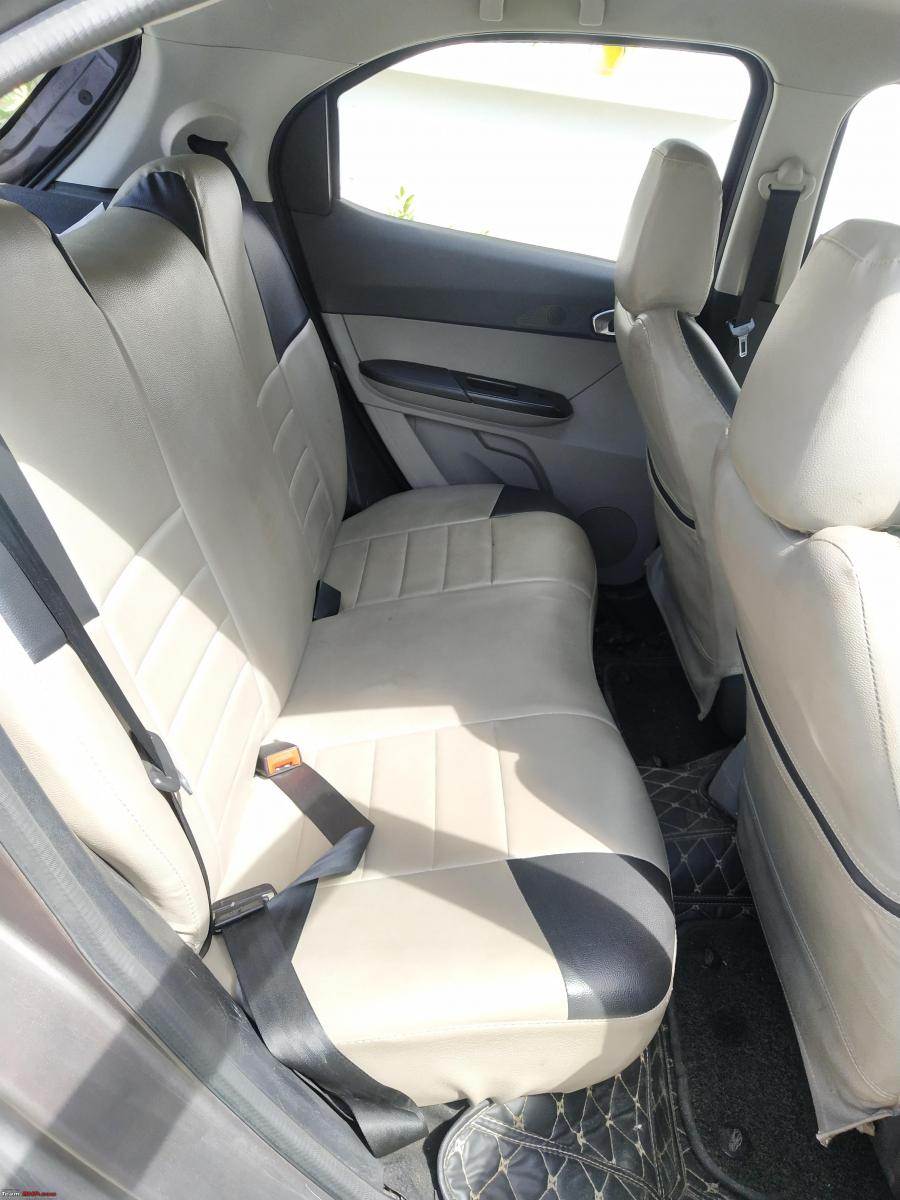

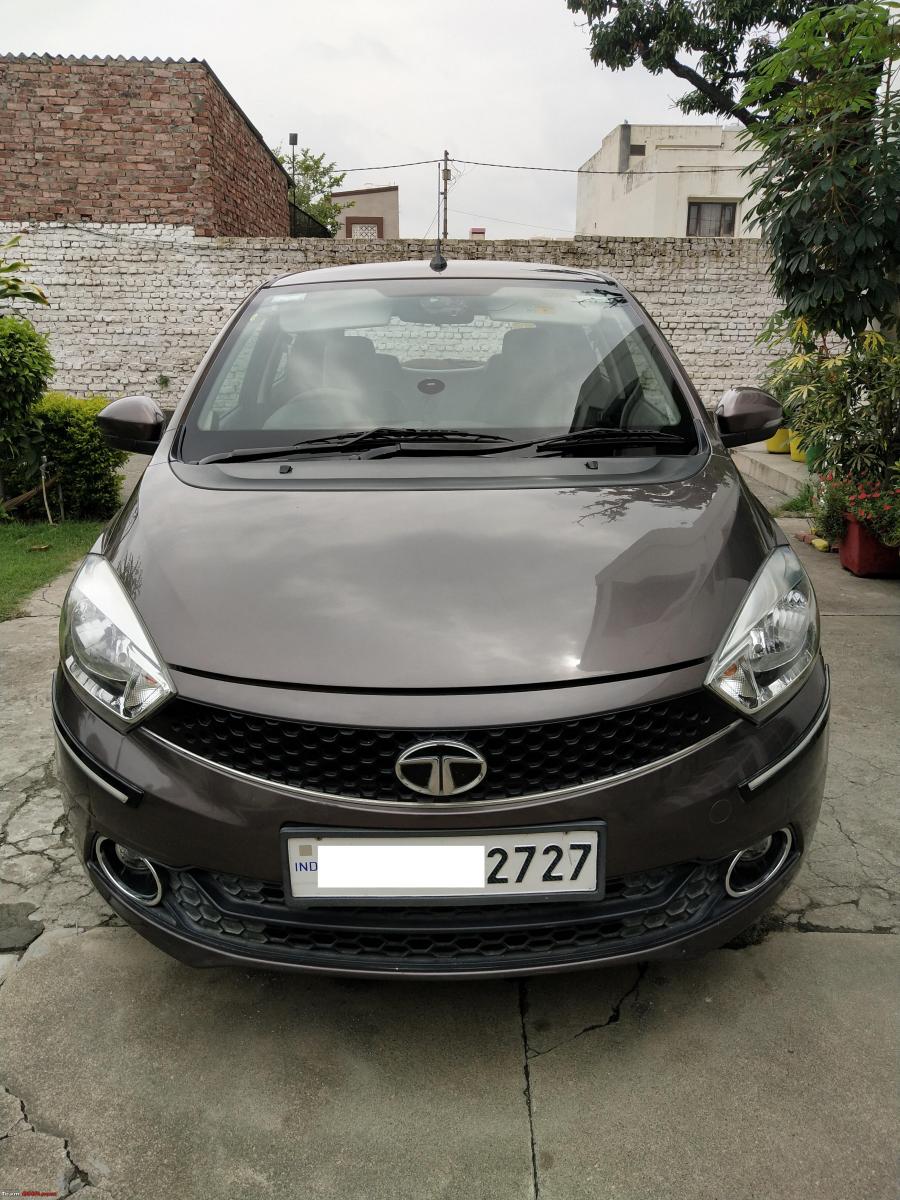

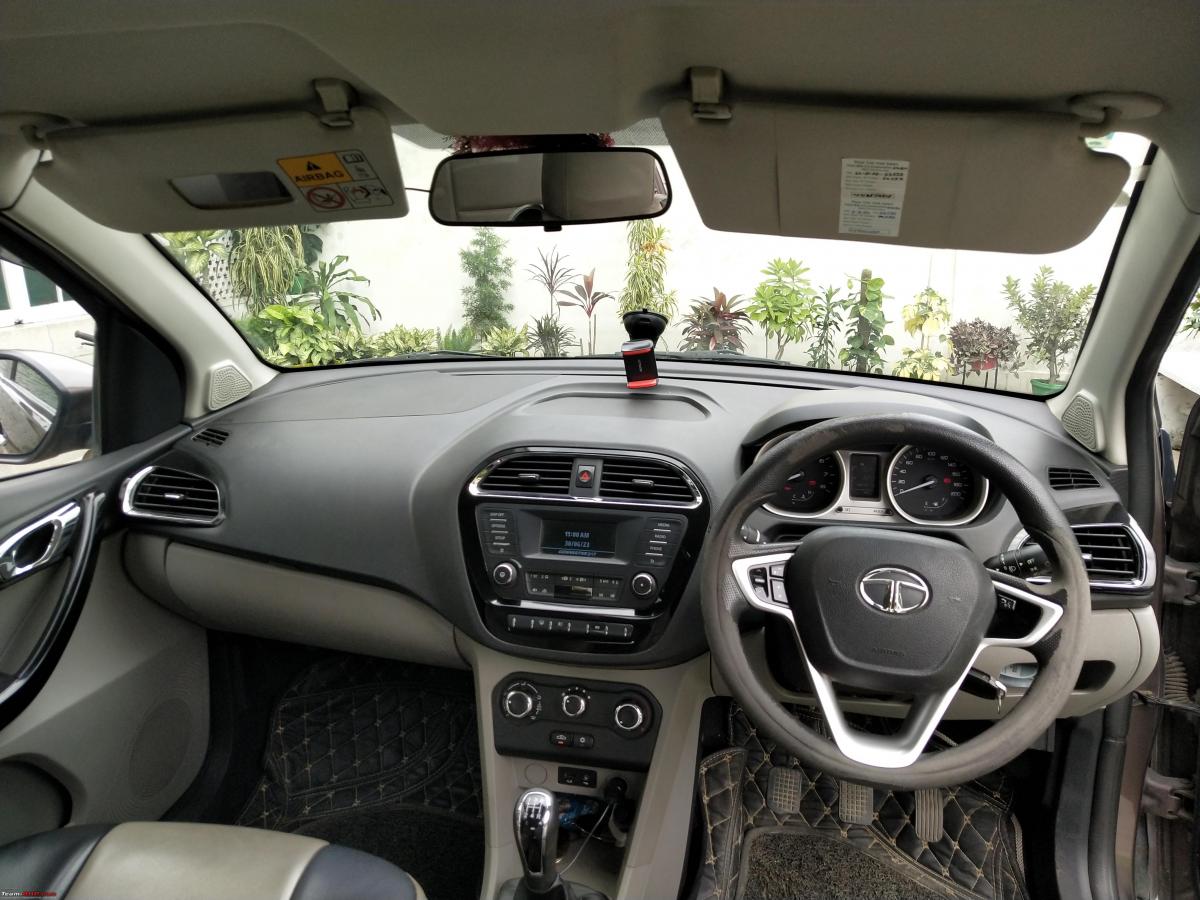

Check out BHPian comments for more insights and information.
- Tags:
- Indian
- Tata Tiago
- Tata
- Review
News
2023 Audi Q8 e-tron : Our observations after a day of driving
The Audi Q8 e-tron's adaptive air suspension is more than just a trick though. It offers a near-magic carpet-like ride quality.
Driving the Q8 e-tron
Thumb the starter whilst keeping the brake pedal depressed and you will be greeted by an uncharacteristic "whir" from the electric motor rated at 300 kW backed by a (now-larger) 114 kWh battery pack. For reference, the outgoing e-tron was equipped with a smaller 95 kWh battery pack. This, along with the now improved drag-coefficient values of the Q8 e-tron, has resulted in an overall improvement of the car’s range by 32% as claimed by Audi. The SUV and Sportback variants can now do 582 km and 600 km on a full charge in ideal circumstances.
For those who want plain and simple numbers, the motor delivers a claimed 408 BHP and is capable of hitting the century mark (100 km/h) from a standstill (0 km/h) in about 5.7 seconds. Audi claims that the Sportback variant can achieve the same target slightly quicker than the SUV, i.e. in 5.6 seconds.
Ease off the brake pedal and the car remains stationary. There is no creep function in this car. Dab the throttle pedal and the car gets going in a smooth and controlled manner. One thing that strikes you about this car, as it gets going, is just how smooth, silent and refined the drivetrain is. Vibrations are nearly non-existent, and the power delivery is linear and progressive.
Give it a boot-full however, and the car catapults you forward with the sort of ferocity that very few ICE-powered cars could. People who talk about ICE-powered cars delivering instant torque with no turbo lag should experience the Q8 e-tron to truly understand the meaning of "instant torque" and "no lag".
The feeling is akin to what one would experience in a passenger airliner, just as the aircraft is done with its taxiing procedures and the pilot engages maximum thrust. It truly pins you to the back of your seat and sends you down the road, sans the drama you may expect from an ICE-powered sportscar.
If the battery pack and the electric motor are up to the task, i.e. well charged and reasonably cool in terms of battery-pack temperatures, the car will allow you to tap into its reserves and give you maximum boost when the throttle is pinned to the floor. The sensation that maximum boost provides is so ferocious and severe that you begin to wonder why you need that elusive sportscar/supercar that’s on your bucket list.
And then you are reminded about the drama, or rather the lack thereof, that the electric motor fails to deliver. This is where the EV drivetrain is often found lacking – the drama that an ICE-powered car delivers, in the form of varied levels of power delivery and of course, a characterful exhaust note accompanying the ferocity of the motor. It may seem irrelevant to those who crave outright power and performance, and while we certainly see the appeal in quiet performance that the Q8 e-tron delivers in spades, we are after all automobile enthusiasts deep down and at heart. And to us, the appeal wears off quickly and we are left wanting some drama and character from the Q8 e-tron.
This brings us to a quote from the internet that we must mention: Comparing the performance of an electric car to that of an ICE-powered car is like comparing the performance and efficiency of a microwave to that of a barbeque grill. The microwave may cook food faster and more efficiently, but have you ever heard of someone inviting you over to join them for a microwave party?
Under the bonnet is one of the electric motors:

Frunk sits in the middle of the bay:

It is designed to carry the charging cable:

Comes with a light:

Suspension
If there was one aspect of the Q8 e-tron that blew us away, it is the ride, handling and braking. It is perhaps one of the most dynamically accomplished cars we have driven.
For starters, the steering is quite un-Audi-like as it delivers plenty of feel and feedback, even if it’s artificial. The calibration work undertaken to set it up could not have been done better, all things considered. The car turns in sharply and does not feel lazy or dead off-center – something Audis have been rather guilty of lately. It is very quick and direct, making it perfect for a spot of hustling on your favourite B-road.
The steering is complemented perfectly by the car’s adaptive air suspension that can be set up using 7 drive modes: Dynamic, Efficiency, All-Road, Off-Road, Auto, Comfort, and Individual.
Engaging Dynamic mode via the touchscreen on the dashboard drops the car down from its standard ride height of about 175 mm to its lowest possible ride height (149 mm). It also firms up the ride without making it too stiff. The car feels predictably pointy and tighter in Dynamic mode. Efficiency mode raises the ride height a touch from its lowest setting but still keeps it lower than the standard ride height. All-Road mode raises the ride height by about 35 mm from the standard, allowing for easier traversal of rough roads. Off-Road mode raises it by an additional 35 mm over All-Road mode, giving the Q8 e-tron enough ground clearance to tackle tough trails and tricky courses, should the need arise. Auto mode allows the onboard electronic suspension platform to work with the 4 level sensors on the car’s axle in order to adapt and optimize the ride height as well as its general characteristics based on prevailing road conditions. Comfort mode softens up the ride a great deal, while Individual mode allows the driver to make adjustments and set up the ride exactly the way he would want it.
In Dynamic, Off-Road and Auto modes, the drivetrain sends power and torque to all four wheels a.k.a. Quattro! However, in the standard driving modes the drivetrain sends power only to the rear wheels – which makes the Q8 e-tron possibly the first RWD Audi since the R8 supercar!
That said, the front axle will automatically receive power and torque when the onboard computers deem it necessary. Variable torque distribution helps regulate torque split between individual wheels and axles, based on road conditions and driving situations. Selective wheel torque intervention via the brakes helps control the amount of torque being sent to individual wheels, further aiding the car’s handling and allowing it to rotate around the corner harder and quicker!
The car’s adaptive air suspension is more than just a trick though. It offers a near-magic carpet-like ride quality. No matter how bad or good the road seems to be, the suspension allows the car to breathe with the road surface and absorb all the ruts, potholes and undulations without breaking a sweat. Even in Dynamic mode, the car simply sailed over all the rough stuff, while in Comfort mode, it dismissed potholes and ruts like they did not exist!
With such an accomplished ride, one would assume that the handling would be compromised. However, the manner in which the car negotiated corners and bends left us amazed. It truly does feel like it’s on rails! Nothing seemed to unsettle the car, and we threw everything at it! While you do feel the heft of the car around a fast corner, the chassis of the car gives its driver the feeling of being shrink-wrapped. It’s relatively easy for even novice drivers to negotiate fast corners.
All this of course comes at a price. Long-term reliability and maintenance of the adaptive air suspension is a bit of a question mark. Replacement kits are certainly not going to be cheap, and while the suspension may be robust enough to deal with everyday driving, Indian roads can pose a serious challenge. Therefore, long-term reliability remains to be seen.
Braking performance also took us by surprise. It is amazing how the brake pedal offers so much feedback and feel, despite all the tech tied to it. We had a couple of moments where we expected to fly over unmarked speed-breakers that we had failed to spot in time, but a firm push on the brake pedal is all it needed to bring it down to crawling speeds. A visual inspection of the brake discs and callipers led us to believe that the braking system was potentially taken from one of the hot Audi ‘S’ or ‘RS’ variants.
Safety & Technology
The Q8 e-tron is loaded to the gills with trick safety features and technology, to the point where you begin to question your involvement as a driver behind its steering wheel.
Our experience driving this car was limited to the road network in and around Nandi Hills and on open stretches of highway. Rarely did we chance upon bumper-to-bumper traffic. But in our limited time driving the Q8 e-tron on B-roads, we understood quickly that the car could easily drive itself. Single-pedal driving can easily get you around. As you approach traffic, coasting at speed, the car reads the distance between itself and the vehicles in front of it and controls its speed by applying the brakes ever so slightly while simultaneously drawing energy from it through the regeneration system.
Being an EV, you can expect the car to have the technology to recuperate lost energy whilst braking through its regeneration technology. While coasting, there is no regeneration whatsoever. However, using the brake pedal with various levels of intensity will help recover lost energy and further builds on the range left in the tank. Alternatively, one can use the left paddle on the steering to mimic engine braking and further coax the car into recuperating lost energy.
The lane-departure warning / assist is one such feature, that tugs the steering and nudges the car back into its lane the moment it notices you driving over the white lane markers. It’s a clever piece of technology but can be annoying when trying to needle your way through slow-moving highway traffic. One way to game it, without turning it off altogether, is to use the indicators liberally, and the system will not intervene.
The Q8 e-tron gets 8 airbags, which, we're pretty certain nobody would want to find out how well they probably work.
The car’s headlights do a neat little party trick by projecting the Audi logo along with a cool e-tron motif onto a wall or any surface you choose to project it on. Sadly, we could not test this out as our drive was during the day.
Along with the car, Audi offers a phone application for Apple and Android users, that its owners can download and monitor the car’s driving remotely. In essence, you could hand the car over to your driver or friend, and you would be notified immediately the moment either of them accelerates, brakes or turns hard! There is no escaping bad behaviour in this car’s driver’s seat, that’s for sure! The app also provides its user with the live location of the car, and a "car finder" in case you don’t remember where you’ve parked it during a mall visit. Charge / range details, concierge services and access to Audi’s rewards club are also offered through the phone application.
In a bid to allow customers a variety of specifications and options to choose from, Audi now offers 48 exterior colour options, 8 interior leather options that can be paired with 11 stitching colour options, two wooden inlay designs and 2 comprehensive exclusive leather packages. This should help set your Q8 e-tron apart from your neighbour's.
Continue reading the discussion on the Audi Q8 e-tron on our forum.
News
2023 Audi Q8 e-tron Review : 7 Pros & 5 Cons
The car catapults you forward with the sort of ferocity that very few ICE-powered cars could. People who talk about ICE-powered cars delivering instant torque with no turbo lag should experience the Q8 e-tron to truly understand the meaning of "instant torque" and "no lag".
Audi Q8 e-tron Pros
- Sophisticated and tech-laden EV developed without leaving any stone unturned
- Stylish & contemporary design language that lets it fit in with ICE-powered cars
- Accomplished drivetrain delivers astonishing performance. Very fast!
- Outstanding ride and handling package. Astounding levels of grip over all surfaces
- Class-leading claimed range of 582 km for the SUV and up to 600 km for the Sportback
- Trick air suspension allows you to switch between sporty dynamics and crossover-like practicality
- Well-appointed and thoughtfully designed cabin
Audi Q8 e-tron Cons
- Not really a Q8. Based on the Q5 LWB mated to an EV drivetrain
- Raised floor results in lack of under-thigh support, especially for taller passengers at the back
- Interior quality is not at the same level as the Petrol Q8. Plastic trim quality below the waistline leaves a lot to be desired in this price segment
- Will be expensive, just like other EVs from the luxury marques
- Neither-here-nor-there design language of the Sportback can be polarizing
Read Team-BHP's detailed 2023 Audi Q8 e-tron Review.
News
Hyundai Exter : Our observations after a day of driving
The Exter has a suspension setup that’s on the softer side. Straight-line stability is good for a car in this segment and occupants won't even know that the car is cruising at triple-digit speeds.
Driving the Hyundai Exter 1.2L Petrol MT
1.2L petrol engine makes 82 BHP @ 6,000 rpm and 114 Nm @ 4,000 rpm:

The Exter is powered by the same 1.2L, 4-cylinder NA petrol that does duty in the Grand i10 Nios, Aura and Venue. It puts out 82 BHP, which is more than the NA units of the Citroen C3, Nissan Magnite and Renault Kiger, but lower than the Maruti Fronx's 89 BHP and Tata Punch's 87 BHP.
The petrol engine has been around for a while now, but it is still a gem of an engine. With your foot on the clutch, press the engine start/stop button. One can immediately notice the sheer refinement of this motor. The petrol starts seamlessly. Torque delivery at low rpms and in city driving conditions is satisfactory by petrol standards. We could pull the engine from 800 rpm without any effort. Use the clutch and the engine will pull from as low as 500 rpm! Closing the gap to the car in front is no problem. One can drive around at 40 km/h in 5th gear with the tachometer reading 1,100 rpm. The refinement levels are outstanding and power comes in smooth. I didn't observe a single flat spot in the entire rpm range.
Prod the engine further and its rev-happy nature becomes immediately evident. The 1.2L petrol feels eager on the open road and climbs clean to the 6,600 rpm limit. There is plenty of mid-range punch. The engine starts coming into its stride and ~1,700 rpm and pulls strongly from ~2,200 rpm Overtaking fast traffic only requires a downshift. Expressway performance is adequate. In terms of cruiseability, in 5th gear, 100 km/h is seen at 2,800 rpm. Overall, we would describe the performance of the Exter to be adequate, but not exciting.
The 5-speed manual transmission is slick to operate. The throws are smooth and sure-slotting. The clutch is super light and the travel range is average.
Noise, Vibration & Harshness (NVH)
There is a very slight shake of the body as the engine cranks, but other than that, there are no vibrations felt inside the cabin. At idle, you will not even know that the engine is running. While driving around calmly, the cabin remains silent. Even at 80 km/h. one doesn’t need to raise his voice to talk to the other occupants of the car. However, as the revs climb past 3,200 rpm or so, the engine makes itself heard in the cabin. The engine feels smooth when high-revving, though it can get fairly vocal over 5,000 rpm. It never sounds rough or bad.
Wind noise starts creeping into the cabin above 100 km/h. While it gets louder with speed, it’s not excessive at 120 km/h. Road noise and tyre noise are average.
Mileage & Fuel Economy
The 1.2L naturally aspirated petrol has an ARAI-certified fuel efficiency of 19.4 km/l for the MT and 19.2 km/l for the AMT. In our short drive, which included some fast driving we saw 15-16 km/l on the MID. With better driving, we are pretty sure that the engine will deliver much better FE figures.
No insulation sheet under the bonnet:

No underbody protection. You can see the ground below clearly:
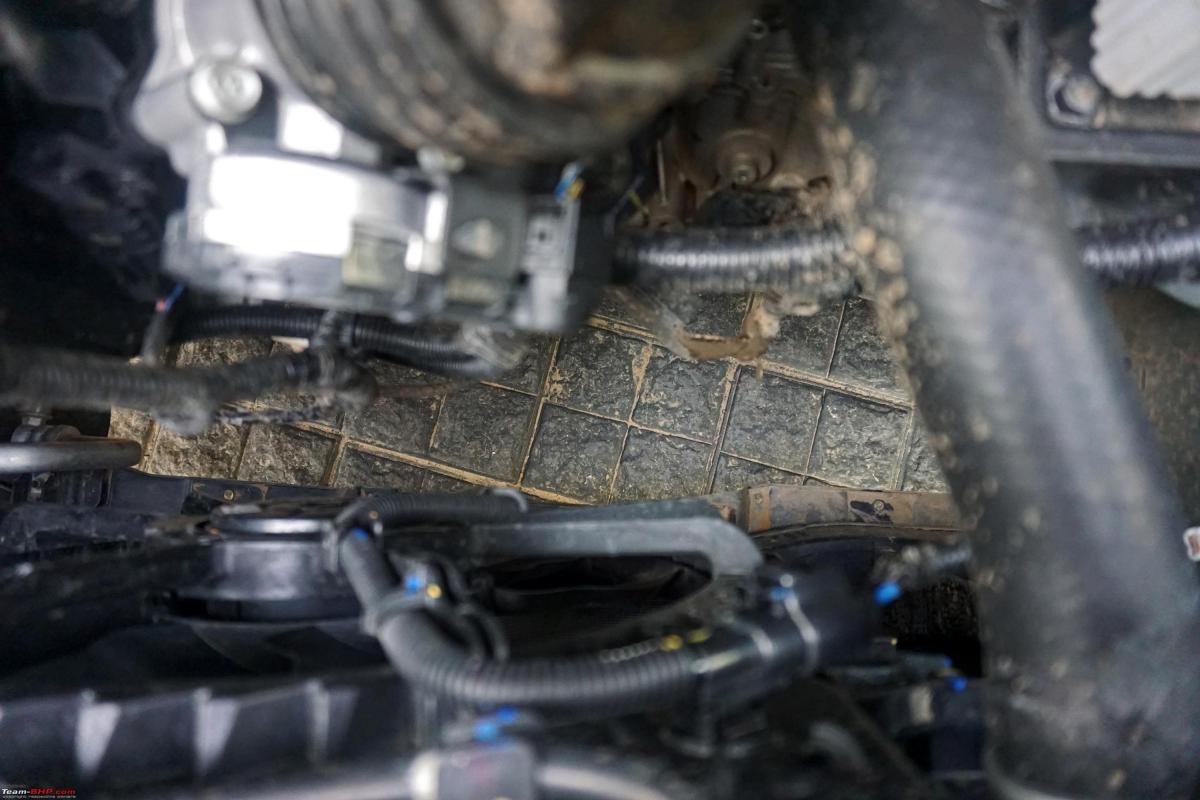
Suspension

Ride Comfort
The Exter comes with a McPherson strut suspension at the front and a coupled torsion beam suspension at the rear. The ride over small potholes and uneven roads at city speed is compliant. No bumps are transmitted hard into the cabin. Even over bad roads, the suspension does a good job of keeping the car's occupants comfortable. Of course, large potholes do register themselves in the cabin, but overall, the ride quality is very compliant. The suspension works silently too.
The higher variants of the Exter ride on 15-inch wheels with 175/65 section tyres and the recommended tyre pressure is 32 PSI.
Handling & Dynamics
The Exter has a suspension setup that’s on the softer side. Straight-line stability is good for a car in this segment and occupants won't even know that the car is cruising at triple-digit speeds. Expansion joints on the highway do not unsettle it, but there it does wallow a little.
On long curves, the car holds its line well. Push the car on twisty roads and you will experience body roll. Our test car came with 175/65 R15 JK UX Royale tyres. While these are fine for regular driving, they are just not good enough for spirited cornering. The body roll, numb steering and skinny tyres mean that the Exter is not very happy being pushed hard on twisty roads. It’s better to drive the car within its limits and yours.
Steering
The Exter gets an electric power steering, which is very user-friendly. It's light at parking and city speeds and most owners will appreciate that. The compact dimensions of the car, light steering and a tight turning radius make it very easy to drive in the city. At higher speeds, the steering weighs up and there’s little vagueness in the centre. However, from an enthusiast's perspective, there’s nothing on offer. It feels very disconnected and light even at high speeds and on twisty roads, you will find that it doesn't relay much feedback.
Braking
The Exter is equipped with disc brakes at the front and drum brakes at the rear. The performance is as expected and the car comes to a halt without much drama. Under hard braking too, the car doesn't lose its composure. That being said, wider tyres would have improved braking further.
Continue reading the discussion on the Hyundai Exter on our forum.
News
2023 Hyundai Exter Review : 12 Pros & 10 Cons
The Exter comes with a McPherson strut suspension at the front and a coupled torsion beam suspension at the rear. The ride over small potholes and uneven roads at city speed is compliant.
Hyundai Exter Pros
- Well-positioned overall package. Priced competitively against rivals
- Unique looks with the H-shaped LED DRLs & tail-lamps and crossover styling
- Super-refined 4-cylinder engine offers good driveability and satisfactory fuel efficiency. AMT and CNG versions are available too
- Hyundai AMTs have superior tuning as compared to the AMTs of Maruti, Tata etc.
- Well-tuned suspension absorbs bumps well and delivers acceptable high-speed stability
- Precise build & quality (including interiors) are among the segment best
- Excellent ergonomics with light and well-placed controls
- Spacious interiors with very good legroom and headroom for a car in this segment
- Accommodating 391-litre boot is among the largest in the segment
- Loaded with features such as a sunroof, keyless entry & go, dashcam with dual camera, auto headlamps, cruise control, paddle shifters, connected car features (BlueLink), wireless charger, rear A/C vents, multi-lingual voice commands, etc
- Safety kit includes 6 airbags, 3-point seatbelts for all 5 occupants, ISOFIX child seat mounts, ABS, EBD, ESC, VSM, hill-hold assist, rear parking sensors and camera, TPMS, emergency stop signal, SOS call and more
- Hyundai's wide service network & up to 7-years extended warranty
Hyundai Exter Cons
- Edgy looks & funky styling may not be to everyone's liking. Cuts and creases are overdone
- Despite the unique styling, it’s not really a head-turner. Small size robs the Exter of road presence
- 1.2L NA petrol’s highway performance is adequate, but not exciting
- No turbo-petrol or diesel engine on offer
- Not as engaging to drive as the Citroen C3 Turbo. Handling, steering and thin tyres won’t appeal to enthusiasts
- Light-coloured interior theme isn’t available. Black interiors may not be to everyone's liking. Hyundai should’ve offered a beige option
- Back seat is more suitable for 2 healthy adults and a child. Not 3 healthy adults
- Rear seat is placed on the lower side, and its under-thigh is average (taller folk will find it to be less)
- Average sound system is no match for some of the rivals (e.g. Punch & Fronx have better ICE)
- Some missing features like foglamps, rear centre armrest, auto-dimming IRVM, 60:40 split rear seat, 6-speaker sound system (Exter has just 4), full-sized spare tyre, etc.
Read Team-BHP's detailed 2023 Hyundai Exter Review.
News
Maruti Invicto : Our observations after a day of driving
On the open road too, the Invicto provides satisfactory performance. There is enough power and torque on offer to keep up with the traffic with ease.
Driving the Invicto 2.0L Hybrid

The Maruti Invicto is powered by a Strong Hybrid Electric System with a 2.0-litre 4-cylinder petrol engine. The car has a 168-cell kWh Ni-MH battery that powers the electric motor. Its combined power is 184 BHP and motor torque is 206 Nm. The engine is paired to an e-CVT with sequential shift.
With your foot on the brake pedal, press the engine start button. It doesn't result in the usual sound of a starter cranking the engine to life; it's eerily silent & for those who haven't experienced electric or hybrid cars before, this does take a little getting used to. Slot the gear lever into D and you're all set to roll.
One of the first things you notice is the absence of a rev counter. It sure feels weird to drive a car without the rpm needle moving up & down. The instant torque from the electric motor ensures that the Invicto immediately darts forward. Low-end torque is good. In heavy traffic, you can drive the car without any throttle input. The petrol engine turns on only when extra shove is required, or if the batteries are below a certain charge level. The engine also switches on when the car crosses ~40 km/h. While the insulation is superb & regular folk won't know, enthusiasts will notice when the petrol engine suddenly kicks in. Whether it is driving in bumper-to-bumper traffic or closing gaps, the Invicto does it effortlessly. The e-CVT provides a seamless experience in the city. As there aren't any actual gear shifts taking place, the drive feels amazingly smooth. Throttle response is good and the rubber-band effect is well-controlled with a light foot on the accelerator. These traits make the Invicto very easy to drive in the city.
On the open road too, the Invicto provides satisfactory performance. There is enough power and torque on offer to keep up with the traffic with ease. The powertrain responds well to throttle inputs and power is always available. Outright performance is strong. Toyota claims that the Hycross can do a 0-100 km/h sprint in under 10 seconds. We believe that the Invicto can achieve this performance too. Slow-moving vehicles are overtaken without any drama. In terms of cruisability, the Invicto proves to be a good mile muncher. It can maintain triple-digit speeds effortlessly. At the same time, the cabin is quiet, cutting out most of the outside noises.
The Invicto gets drive modes that basically alter the throttle response as well as the behaviour of the internal combustion engine. There is a dedicated EV mode button that will let you drive the car as an EV for the max distance possible. However, if you are heavy on the throttle or the car crosses ~40 km/h or the battery's state of charge is too low, the system will go back from EV mode to hybrid mode.
Apart from the EV mode, there are 3 drive modes: Normal, Eco and Power. These 3 modes alter the throttle response.
The Normal mode is the default mode which is in the middle of Eco and Power modes. It works well in town and on the highway and offers a good balance between efficiency and performance. In fact, you really don't need to change it unless you're driving uphill or want to overtake a vehicle quickly on an undivided highway.
In Eco mode, the internal combustion engine doesn't come on as easily unless you press the throttle a lot more. The response is lazier and it tries to keep it in hybrid mode with the internal combustion engine only charging the battery and not sending power to the wheels unless the accelerator is pressed very firmly.
In Power mode, it's the opposite. Even with a light dab of the throttle, the internal combustion motor comes alive and assists the power delivery. On undivided highways, this is the mode to use to pull off safe overtakes. Throttle response is much sharper and you rarely see the internal combustion engine turning off. Of course, this mode impacts fuel efficiency the most. Don't use this mode in the city as power delivery can get a little spiky.
The gearbox also has a manual mode. You can use the gear shifter or the paddles behind the steering wheel to change gears. You'll like the engine braking on offer. The gearbox has an "S" mode too in which the transmission holds the gears for a little longer than in the regular D mode.
Noise, Vibration & Harshness (NVH)
The Invicto's NVH levels are impressive. The car does a good job of keeping most noises out of the cabin most of the time. It's only when you press the accelerator harder that you can hear the 2.0L petrol engine. With the accelerator on the floor, the engine gets loud and intrusive. Accelerate gradually and the cabin remains impressively quiet as the speed builds up. In fact, the insulation is so good that on the go, even the horn of the car is heard very faintly inside the cabin! We did not feel any vibrations even when the petrol motor came on.
Wind noise starts creeping into the cabin above 105 km/h and increases with the speed. Road noise is average.
Mileage & Fuel economy
The Invicto has an ARAI rating of 23.24 km/l. In our short drive, which included some fast driving we saw 16 km/l on the MID. With better driving, we are pretty sure that the hybrid will deliver much better FE figures.
Suspension

Ride Comfort
The Maruti Invicto gets a MacPherson strut suspension at the front and a torsion beam suspension setup at the rear. The suspension is well-tuned to provide a compliant ride. The car rides on 17" rims with 215/60 section tyres. While the sidewalls are taller than the Hycross', they are still rather short. So while the ride is slightly better than the Toyota, it is still far from plush. More bumps and potholes are transmitted to the occupants than we would like. While the ride is still fine, we are pretty sure that it would be better with taller rubber. Even with speeds increasing, the ride remains compliant. We didn't get to check the ride out on very bad roads though.
Handling & Dynamics
High-speed stability is very good. Even at 120 km/h, there is no floatiness or nervousness displayed by the Invicto. While we did not get a winding road to try out the car's handling, we did try some quick lane changes on an empty stretch of road. As expected, the Invicto has more body roll compared to a sedan or crossover. The tyres provide adequate grip and the car sticks to its line through curves. Overall, the Invicto certainly feels quite car-like to drive.
Steering
The Invicto gets electric power steering that is well-calibrated. It is light at slow speeds and gets heavier as the speed goes up. This along with the healthy rake and reach adjustment, makes the Invicto easy to steer. That said, it could do with more feedback.
Braking
Being a hybrid, braking is different compared to conventional cars. With disc brakes all around, the stopping power is good. But the braking needs time to get used to. It's not easy to get a linear braking response. Sometimes you hit a bump faster than you intended to since the braking isn't linear. This needs getting used to. It will catch you off guard initially, but after a while, you get accustomed to it and change your braking style accordingly.
Continue reading the discussion on the Maruti Invicto on our forum.
- Tags:
- Indian
- Invicto MPV
- Review
Pages














